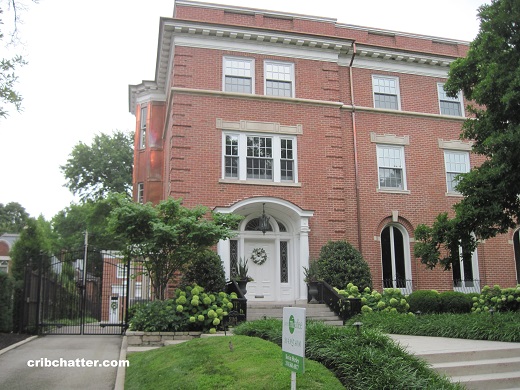Chicago or St. Louis: Who Has the Better Vintage Mansions? 5165 Lindell
This 5-bedroom mansion at 5165 Lindell Boulevard in Central West came on the market in May 2019.
Built in 1908 by architects Mariner & La Beaume, the listing describes it as the “golden age” of St. Louis architecture.
Lindell runs on the north side of Forest Park, the largest urban park in America. It is lined with mansions and backs up to two of the most famous streets in the country: Westmoreland and Portland, which are “private” gated streets that also sport dozens of mansions.
You can’t even walk down Westmoreland or Portland. Here are the Portland Place gates that close off the neighborhood.
This house sports its original millwork and 7 fireplaces.
It has a chef’s kitchen with luxury stainless steel appliances and what looks like a servants kitchen/prep space adjacent to the kitchen.
The third floor has a theater, kitchenette, message room and an outdoor terrace with a hot tub.
There’s a master suite with a spa-like bathroom.
Like any good mansion, it has a carriage house with a guest suite.
The landscaped grounds has a terrace and a saltwater pool.
It has central air and a 3-car garage on a 100×200 lot.
Forest Park is across the street and it’s within blocks of the shops and restaurants of Central West End, which is the Lincoln Park of St. Louis.
Chicago has its share of vintage mansions too but St. Louis’ mansions really show the concentration of wealth around the time it hosted the 1904 Worlds Fair.
Kevin Hurley at Janet McAfee Inc. has the listing. See the pictures here.
5165 Lindell Blvd: 5 bedrooms, 6 baths, 2 half baths, 11,000 square feet
- Was listed in May 2019 at $2,295,000
- Currently still listed at $2,295,000
- Taxes of $23,835
- Central Air
- 7 fireplaces
- Saltwater pool
- Carriage house with guest suite
- 3 car garage
- Bedroom #1: 17×13
- Bedroom #2: 28×26
- Bedroom #3: 19×17
- Bedroom #4: 19×16



Nice enough, but this looks more like a school to me, rather than a home. I don’t particularly care for this style of architecture, does it have a name? Taxes are a lot cheaper than Chicago though.
“Forest Park, the largest urban park in America”
Sorta turns on one’s definition of “urban park”. Not quite sure how Rock Creek Park (~30% larger) doesn’t count, but I’m sure there’s some goofy reason that the statement is accurate in some sense.
“Forest Park, the largest urban park in America”
You’re right. It’s not the largest. Maybe at the time it was created that was true since it’s so old (?) but apparently Chugach State Park in Anchorage takes the crown by a long shot. Forest Park is WAY down the list. Lol.
But it’s still pretty massive and bigger than both Central Park and Golden Gate Park.
These private streets are very nice and you feel you are in another world. The security guards are very active and will politely shoo you away. The houses are stunning and eight years ago prices seemed reasonable in this area.
“Chugach State Park in Anchorage takes the crown by a long shot”
Most of the really big ones can be distinguished in some fashion–Chugach hardly counts as urban–it’s technically in the City of Anchorage, but there’s no city on 3 sides of the park.
Fairmount Park, in Philly, seems to be both older and larger, so there probably is some further distinguishing definition–I’ve heard the same thing before about Forest Park, so there’s probably some nugget of truth in there somehow.
“Fairmount Park, in Philly, seems to be both older and larger, so there probably is some further distinguishing definition”
Good question. I don’t know how they define it. Lots of parks are bigger than Forest Park though. Fairmount Park is amazing.
“The security guards are very active and will politely shoo you away.”
I didn’t see any guards but they could have been driving around doing rounds or something. For Portland and Westmoreland, you cannot even walk in, so there’s no “shooing.”
Apparently Pershing is “private” too but I didn’t see any guards there and it seemed like a normal street. There was no barrier to get in except one part of the street did dead end. It seemed that the rich neighborhoods liked to have one way in and out so you couldn’t just “drive by” on your way somewhere else.
You really can’t blame anyone in this neighborhood. I can’t imagine what it was like in the 1970s and 80s. I’m surprised the mansions survived.
Just 3 or 4 blocks of here is where the neighborhood “turns” and is mostly abandoned with houses anywhere from $10,000 to $50,000.
That’s why the southern part of the city seems like it has moved further along in gentrification and bringing life back to the abandoned homes/buildings. It is further away from the abandoned north side.
The impression I got from my STL friends is that the “private streets” aren’t actually private but just something done by a lot of the original developers to look “private” and exclusive, though, obviously, some are. Chalk it up to a regional quirk.